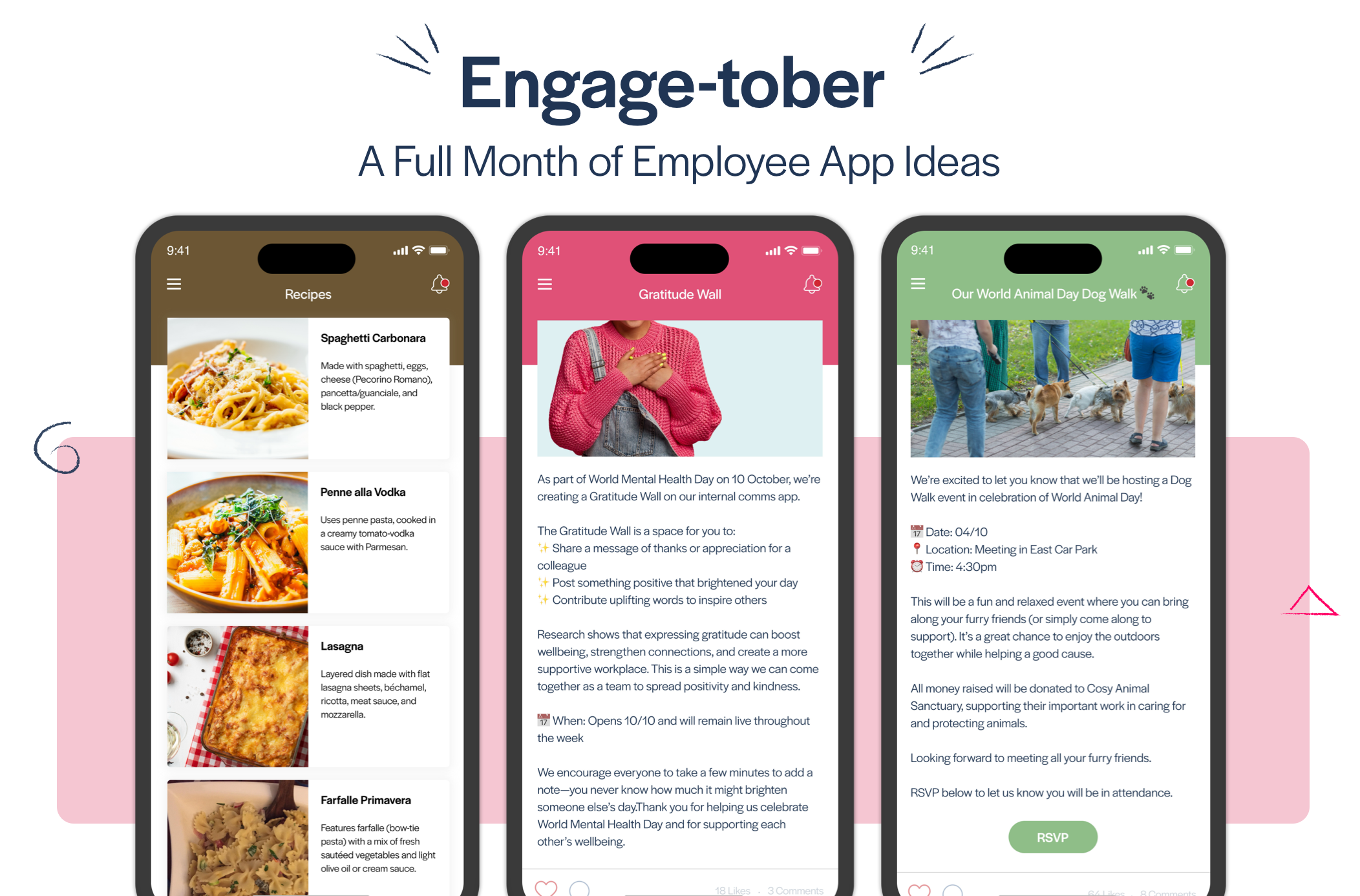
Blog
Intranets vs. Employee Apps: Why It’s Time to Make the Switch
Internal websites—familiarly known as Intranets—have long been the gold standard for workplace communication. But with increasing advancements in digital technology, paired with an abundance of flexibility, employee apps are proving that there really is a better way.

Since the dawning of the digital age, business owners and managers have sought meaningful ways to communicate critical information to their employees. For many decades now, this has taken the form of company Intranets, which are essentially a semi-private tool for posting and sharing company updates, policies and forms, personal employee data, and more.
When compared to the methods of the pre-digital past—such as documenting everything via physical paperwork, then holding meetings to share out the information with teams and individuals—Intranets were a vast improvement. These sites offered a comprehensive “single source of truth,” where employers could save important documentation for employees to reference at any time. And even more importantly, the sites provided a level of security to keep this information safe behind varying levels of login access.

Still, despite the many benefits of Intranets when compared to other more analogue approaches to company-wide communications, these internal sites have also brought their share of headaches. There’s the general difficulty of use (managers frequently describe these sites as having a “clunky” user experience, if not being completely inaccessible at times), as well as the lack of flexibility for a manager or HR team member to make necessary changes without involving IT or a web developer.
There’s also the lack of consistency across Intranet sites, which means constant training is needed when onboarding even experienced employees—a drain on internal resources that seemingly never ends.
Business owners and managers have long sought a better alternative. But even with the emergence of employee apps in recent years, many have doubted that these user-friendly, pocket-sized tools could possibly handle the breadth of functionalities they need. How could an employee app be informative, easy to use, and handle the many informational demands of the organisation, from the HR team down to each individual department and employee?
The truth is, employee apps can do all of that, and more. Here, we identify the primary pain points for organisations that still rely on an Intranet site, and we share four ways that an employee app like Thrive.App can offer a better alternative for employees, managers, admins—and even the company’s bottom line.

What Is an Intranet?
First things first: let’s clarify what, specifically, an Intranet actually is. This sort of internal site is technically software that has been developed to enable a company to share information with employees. It’s built with “levels” of access that allow some information, such as an annual holiday calendar, to be visible to all employees, while it restricts other information, such as departmental budgets, to only those managers or individuals who need to see it.
The goal of an Intranet is to facilitate information-sharing, but only within the company. It has a narrow and specific audience, and as a result, contractors and suppliers are typically not granted access to the Intranet site. Depending on the organisation, an Intranet can have varying degrees of usefulness. Some companies have used an Intranet site to an admirable extent, providing useful answers to a variety of questions; others have found the site to be so technically confounding that they barely post information to it at all.

What Is an Employee App?
To be crystal clear about the differences between an Intranet and an employee app, it’s helpful to define the latter once more in context. An employee app is a digital solution that enables everyone within an organisation to access company-related information from anywhere. Like an Intranet, it can include all sorts of pertinent company and employee information. But unlike an Intranet, an employee app is inherently user-friendly and easy to set up.
The differences between the solutions can vary depending on the specific Intranet deployment and the specific employee app. But the improvements are universal and can be felt almost immediately when switching to an app: managers can easily self-service the platform with their own updates, without needing to submit a ticket for help from IT or a developer, while employees—even new hires—can access that information without any training or onboarding needed.
In fact, an employee app is designed to be so intuitive and easy to use that employees can access the information they need at the touch of a button, without ever having opened the app before. Even better, managers and HR can send push alerts to employees whenever there’s an important announcement, and such notifications are almost impossible to miss.

Why It's Time to Switch
#1 Employee apps offer a better user experience for all
While Intranet usage varies greatly by company (and this often depends on how well the company has designed and implemented its specific Intranet to begin with), it’s not uncommon for employees to report that they have never once opened their Intranet site. Among the most common reasons they typically cite for this? Not understanding how to log in.
Intranet sites often require significant training, and even once trained, they are usually quite complex to navigate. For those employees who do endure the tedious training sessions, many go on to encounter such a poor user experience that their first login is also their last.
In contrast, an employee app is designed to be used—both early on in an employee’s onboarding, and often throughout their employment. An employee app like the Thrive App is so intuitive that employees can download and begin using it on their very first day. This means there is an immediate benefit to the employee, as well as a long-term payoff to the company, which will save on unnecessary training costs.

#2 Employee apps are more personalised and engaging
A company Intranet typically “is what it is,” meaning it offers the same basic user experience to managers, employees, and HR administrators alike. Whether you log in as a new employee hoping to find information, or as a department leader seeking to share information, you are likely to encounter the same dashboard and general navigation—plus or minus a few options depending on your login clearance.
On the other hand, an employee app can be highly personalised, enabling an employer to set up an interface that works for their needs and preferences. It’s no secret that customisation drives engagement - according to Salesforce, as reported by Forbes, 70% of those surveyed say that personalisation influences their loyalty. What’s more, new data from Econsultancy in the same report shows that 80% of companies report seeing an improvement to their bottom line since implementing personalisation.

#3 Employee apps are easier (and cheaper) to maintain
The simple fact is that Intranet sites require extensive development time and resources to build, and they are just as complicated and expensive to maintain over time. In many cases, an Intranet site will require pulling in an IT team member, an in-house web developer, or even a contractor, simply to post a quick update. It’s a cumbersome process for managers, HR team members, and other administrators, and it’s a very real drain on company resources—both human and fiscal.
Employee apps, like Thrive.App, are designed to work without complex layers of digital or technical support. They can be customised to your company’s exacting specifications, then used freely and easily by your managers and designated admins—as well as by your employees, who can access all the information they need about the company, from anywhere, any time. All of this at a fraction of the cost of updating an Intranet site.

#4 Employee apps better enable remote work
According to new research published by The Ladders for 2022, data projections show that 25% of all professional jobs in North America will be remote by the end of this year. In the UK and Ireland, some data suggests that we may already be at that level now.
The fact is, most Intranet sites were designed and developed to address the needs of an in-office environment; from building policies and procedures, to parking and transit information, to mixers, meetings, and other in-person workplace events. To the remote employee, now comprising roughly a quarter of the professional workforce (and in some industries, much more), many of these Intranet site features and offerings are utterly useless.
In contrast, an employee app is actually even more valuable to the remote worker, giving both desked and deskless employees quick and easy access to all of the company-wide information they need in one tap—while also providing a sense of community within the same digital environment. Employees can interact with one another, ask questions of their managers, request time off, share stories and other information, and stay connected to what’s going on—even from home.

The Future of Workplace Communication Is the Employee App
There are many reasons that an employee app can outperform the capabilities of a corporate Intranet site; from greater flexibility, to a better user experience, to a more agile way for managers to self-serve without the need for expensive IT or development resources—all of which can positively impact a company’s bottom line.
But perhaps the most compelling reason to switch from an ageing Intranet site to a customised employee app is the fact that increasingly more workers are beginning to need exactly that. From the UK and Ireland to North American markets and beyond, it’s clear that remote work in the professional sector is here to stay.
And with Intranet sites and employee apps providing vastly different services and user experiences, the choice between the two solutions is becoming increasingly clear: employee apps offer all the tools that both managers and employees need to succeed in their roles, all at a lower cost to the company.

Want to Know More?
Check out our free eGuide on the Future of Work and the Employee App for more on how the employee app is the communications tool best equipped to support employers as we move into a new way of working.
If your organisation is still using an Intranet, we’d love to have a chat with you and see how a Thrive App could support your employee communication and engagement goals. Get in touch with the Thrive team today for a free demo or watch the Thrive App in action here!









